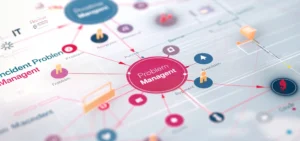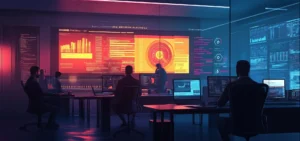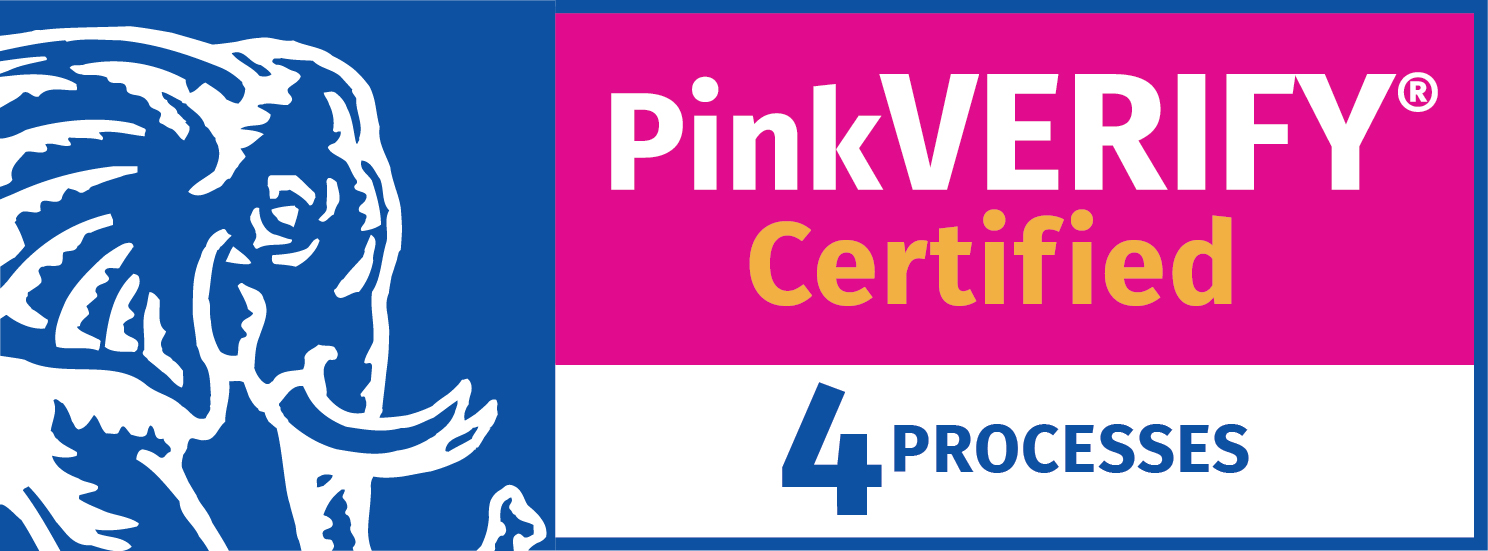Did you know the average monthly volume of IT tickets across all industries is 0.54 per user?
In a company with 1000 employees, that amounts to 540 tickets a month, or 27 per business day!
In hi-tech, the numbers are much higher: 1.38 tickets per user per month, or 69 tickets per day for a 1000-strong organization.
With figures like these, an IT ticketing system will be your best friend.
An IT ticketing system, also known as help desk ticketing, is a tool used to track IT service requests, events, incidents, and alerts that might require additional action from the IT department. Whether you are tackling 500 or 2000 IT tickets per month, a ticketing system helps streamline the workload of your IT team and boost efficiency and performance in resolving IT issues.
Before we dive into more details about ticketing systems, the components, benefits, and features, let’s take a step back and define what is an IT ticket.
What is a ticket?
A ticket, or an IT ticket, is a term referring to a support request or reporting of an issue in the IT system of an organization. Tickets are submitted by users, such as employees or contractors who have been given access to the company’s network or hardware. For MSPs, tickets are submitted by customers who may need technical support or assistance.
IT tickets can involve issues with any part of the IT ecosystem, from software and hardware to network connectivity. It may involve a laptop, mobile phone, printer, internet connection, or software subscription, among many others.
For example, an employee needs access to a particular software, so they open an IT ticket to request a user account. Or the employee’s mouse is not working, so they submit a ticket to get a new one.
Tickets are submitted and managed via the IT ticketing system, which acts as the ‘portal’ connecting the IT team to the users. The ticket includes all the relevant information about the issue being reported, such as the user details, the type of equipment involved, the problem, the urgency level, and any other notes or comments that the user includes.
When an IT ticket is submitted, the ticketing system automatically reviews it, categorizes it, prioritizes it, and assigns it to a technician. Once the ticket is resolved, it can be closed. An IT ticketing system handles all incoming inquiries and requests in an organized and systematic way, tracking the progress of support requests and helping to resolve problems quickly and effectively.
Why do organizations need a ticketing system?
Imagine a medical technology company with 500 employees. Each has a laptop, mobile phone, and varying access permissions to the company network and software. With organizations using an average of 130 SaaS applications, employees also need support for all kinds of tools.
These 500 staff members are spread out over two locations, plus the company works in hybrid mode, so different employees are in the office on different days of the week. Also, don’t forget the remote team of 12 employees who are operating in two countries abroad!
The scenario above is common, and there are endless variations. It also explains why an IT ticketing system is so important to ensure smooth IT operations.
Let’s look more closely at the reasons why organizations of all shapes and sizes need an IT ticketing system:
Tracking IT issues
An IT ticketing system enables the IT team to track and record all reported IT issues, so none are overlooked or forgotten. It centralizes all requests in one platform, keeping the workflow systematic and organized, which helps to manage and prioritize tasks effectively.
Communication
The ticketing system facilitates clear and documented communication between users and IT staff, reducing misunderstandings and ensuring that all relevant information is captured.
Continuous improvement
An IT ticketing system records the data for all tickets across time, helping to identify recurring issues and analyze response times and resolution rates. This provides valuable insights to identify where improvements can be made in IT service delivery.
Meeting SLAs
An IT ticketing system provides a ‘window’ into the activities of the IT staff, measuring service levels and demonstrating their performance in terms of SLA. Tracking and monitoring of IT tickets also enable the IT team to verify whether the service level has changed after activities to improve it have been carried out.
Automation
Automation capabilities help IT teams manage their workload more efficiently, leading to faster resolution times. Moreover, with automation, much of the manual, Sisyphean work of IT ticketing is taken away from the IT team, freeing their time to work on more meaningful tasks. For example, IT staff can focus more on innovating new tools that can add value to the business.
Business continuity
IT ticketing software helps to minimize downtime and prevent interruptions to business operations and functioning. This is crucial to avoid the financial losses that occur when IT networks or devices are problematic or slow.
Customer satisfaction
With a ticketing system, users can track the status of their requests and IT staff are held accountable for their response and resolution times. When IT teams deliver good service and handle issues smoothly and promptly, satisfaction levels among the company’s workforce increase, creating a more productive environment.
Components of IT ticketing systems
An IT ticketing system is an automated workflow built of several key parts that work together to manage and resolve IT issues efficiently. The main components of IT ticketing systems include:
- Ticket creation and submission: Users can open and submit tickets via various channels, such as email, portal, chat apps, Slack or directly within the ticketing system. The ticket includes all the relevant details of the IT problem or request, which are recorded in the system.
- Ticket management: The ticketing system includes features for categorizing, prioritizing, assigning, and tracking tickets. This allows IT staff to coordinate and manage their workload effectively.
- Automation: Many IT ticketing systems include automation rules and AI-based processes that streamline ticket routing, notifications, escalations, and status updates. Automated workflows remove much of the menial work of the ticketing process, freeing up time for resolving IT issues rather than just paper pushing.
- Knowledge base: Routine and simple tasks should not take up valuable time and resources from the IT department. Ticketing systems include a knowledge base with articles, FAQs, and troubleshooting guides that users and IT staff can access on demand to help resolve common issues without having to open a new ticket.
- Dashboard: The front-end interface includes separate dashboards for users and IT agents that feature ticketing functions and communication tools, like email and chat. The IT team manages tickets via the agent dashboard, while customers submit tickets and monitor the status of their tickets on the user dashboards.
- Integrations: A solid ticketing software can integrate with other IT and business systems, such as CRM, ERP, and monitoring tools. This helps to create a seamless information flow across the organization and enhanced functionality for internal and external users.
- Reporting and analytics: Tools for generating reports and analyzing metrics like ticket volumes, response times, resolution rates, and other KPIs enable IT teams to monitor performance and pinpoint areas for improvement.
Going beyond ticketing with ITSM
IT ticketing is one part of the bigger picture of IT Service Management.
IT ticketing focuses on handling individual user requests for incident support and technical assistance. ITSM includes this function as part of a holistic framework that aims to improve IT service quality and align IT services with overall business goals.
What are some of the processes and practices of ITSM that work alongside IT ticketing to improve IT services? Here are some examples:
- Knowledge Management: Managing a repository of on-demand information about how to resolve issues independently, saving time and resources for the IT department.
- Change Management: Ensuring that changes to IT services are carried out in a controlled manner, minimizing risk and disruptions to the company’s functioning.
- Problem Management: Identifying and resolving the root causes of recurring incidents to prevent future occurrences.
- Asset Management: Tracking and managing hardware and software across the organization, to maximize efficiency and reduce costs.
Benefits of an IT ticketing system
The average cost of handling an IT ticket manually is $22. For more complex and ongoing IT tickets, the true cost rises substantially. Yet the benefits of an IT ticketing system go beyond just economics.
All IT tickets, automated and in one place
IT ticketing software automates the ticket lifecycle, including prioritizing tickets according to urgency level and assigning them to a technician. This reduces the manual workload and helps IT teams become more efficient and productive. The ticketing system also provides a single platform where all IT tickets are handled and tracked, so the entire organization is aligned and up to date.
Real-time tracking and communication
In midsize to large organizations, managing and resolving IT issues is impossible without a tracking system. There are too many people, devices, and factors in play. An IT ticketing system facilitates clear and documented interactions between users and IT staff, and the entire ticket transaction is monitored and recorded. It also allows users to track the status of their tickets in real-time, reducing the need for follow-up inquiries and minimizing confusion.
Makes IT Teams Smarter
With an IT ticketing system, the IT team can analyze data on a range of performance indicators, such as the volume of tickets, response times, and recurring problems. These insights are invaluable to improving service quality. It also helps detect trends in ticketing activity. For example, if resolution rates are dropping, this raises a red flag alerting the IT manager to investigate the cause and rectify it.
Digital transformation
Global spend on digital transformation in organizations is estimated at over $2 trillion a year.
Digital transformation (DX) is a big business, but it is also a smart business. As the world becomes more digitized, people have come to expect the smooth efficiency and simplicity of online automated processes. The same is true for IT ticketing.
Transforming the IT helpdesk to a digital system automates the management of incidents, requests, and problems, and streamlines the communication between IT staff and their user base.
Even so, a digital tool is only as good as the customer adoption rate. Digital ticketing systems like IT Care Center put the user experience first, enabling customers to submit and track tickets via portal, mobile, email, BOT, Slack, WhatsApp, or MS Teams. This self-serve approach places a sense of control in their hands while providing a smooth, accessible digital experience, which encourages users to engage and make the most of their IT ticketing tool.
Another bonus of digital transformation in ticketing systems is the data analytics it provides. Armed with insights about ticketing metrics and resolution performance, IT teams can work towards continuous improvement. Finally, integrating IT ticketing with broader ITSM frameworks helps to align IT services with business goals. In fact, IT ticketing is a pillar that supports and accelerates digital transformation across the organization as a whole, driving operational excellence and enabling businesses to adapt and thrive in a digital era.
Who’s taking care of your IT ticketing system?
ITCC does IT ticketing the right way. Request a demo today and see how ITCC can support the digital transformation of your help desk while offering all the modules of a complete ITSM solution in one license.





